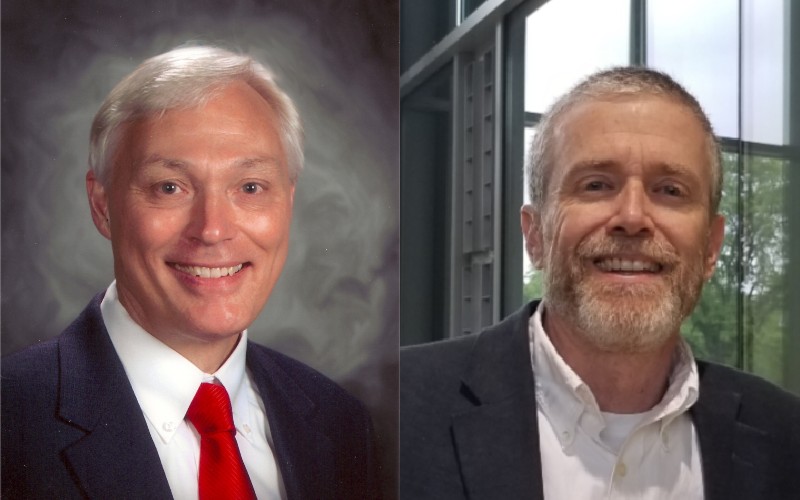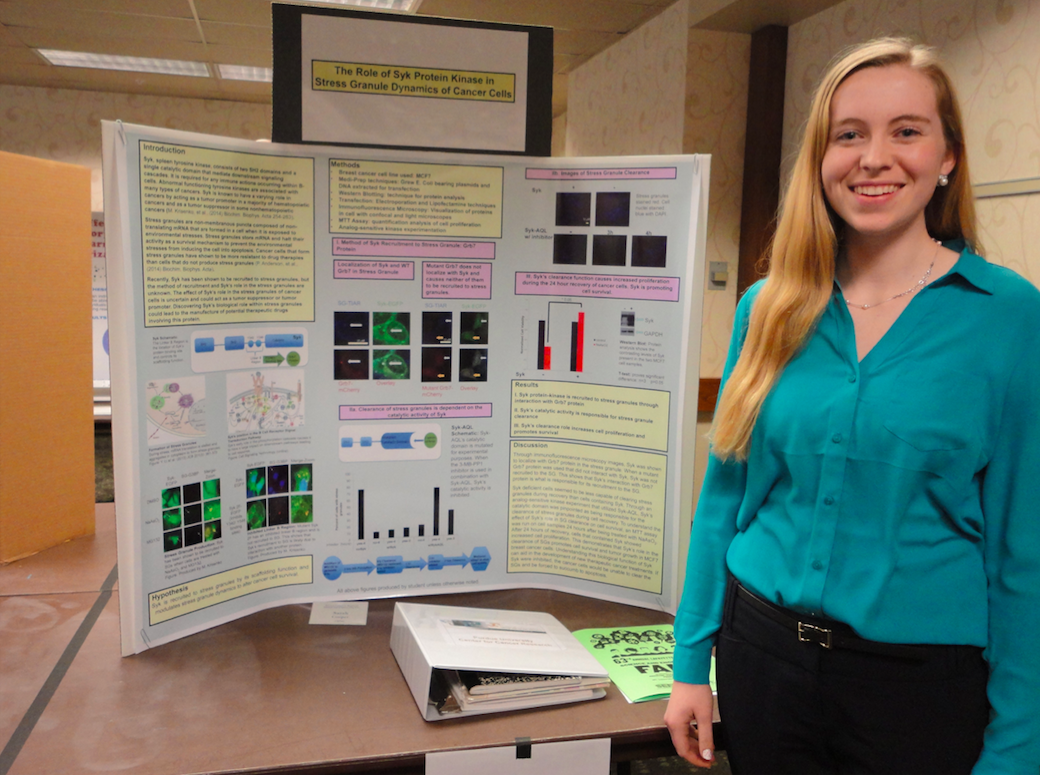Early Steps toward Purdue Research Shape a High School Legacy

Joe Ruhl, who retired this spring after 42 years as a biology teacher—and a force of nature—at Jefferson High, has helped to forge many rewarding paths not only for his students, but for his school and for faculty members on the Purdue campus across the Wabash River in West Lafayette.
His own journey has earned rewards, too. Among them, he was named Indiana’s recipient of the Presidential Award for Excellence in Science Teaching in 1989. He returned to the White House in 2017 as one of five educators inducted into the National Teachers Hall of Fame. Ruhl, who holds both a B.S. in biology (1977) and an M.S. in biology education (1980) from Purdue, plans to continue his sideline efforts as a motivational speaker.
“I like to share ideas with teachers on how to inspire students,” he said in an interview. The key is fostering a network of caring relationships among the young people themselves, as well as “feedback loops” where they energize their teachers and vice versa. Since 1997, when he initiated an independent science research course, he has extended the radius of encouragement—pairing up “passionate” students with the laboratory-based endeavors of Purdue professors advancing knowledge in similar fields of interest.
Those endeavors, allowing high school juniors to do a year’s worth of hands-on work, tied to the high-stakes research and a professor’s personal mentoring (alongside the lab’s team of graduate students), initially focused on the sciences. They tapped into Ruhl’s identification of promising performers in his ninth-grade biology honors course and his pursuit of local friendships with outreach-prone faculty members at his renowned alma mater.
In 2002, the students’ options grew to include cutting-edge experience in engineering, too—“something that most kids in high school had never experienced,” says Prof. Rod Trice, Ph.D., a materials engineer developing manufacturing techniques for heat-resistant ceramic materials in aviation. A grant he had received from the National Science Foundation proposed involving high schoolers in his research. He contacted Ruhl after learning of his reputation for matching young people’s talents to real-world projects.
That was the start of another set of great relationships. During nearly two decades, Trice has welcomed into his lab many different Jefferson High students whom Ruhl had carefully vetted for their talent, diligence, and interest in engineering. Aligned with the structure Ruhl created for the independent research course, juniors could spend significant, supervised hands-on time in Trice’s lab; their collection of data and overall insights—plus immersion in journal articles and development of communication skills—would lead to a detailed presentation for that year’s Indiana regional science fair competition.
Their efforts could begin with a paid internship during the summer prior to junior year and could even extend into senior year if justified by their progress. Along with science-centered members of Ruhl’s class (exploring botany, biochemistry, veterinary science, and much more), those preparing engineering presentations could advance to statewide—and even international—science fairs.
Trice recalls how impressed he became early on—not only with students who established small but substantial niches of competence within the outstanding lab research teams, but with Ruhl. Between 1997 and 2020, Ruhl has cultivated more than 300 young people ready for fast-tracked learning—many of them representing Jefferson High’s diverse student body.
“I don’t know how he does it,” Trice says, calling Ruhl an educator who’s “one in ten million.”
Ruhl returns the compliment. “Rod Trice has been one of the star mentors,” he says. Trice and his lab associates “have done a wonderful job inspiring students” by welcoming them into relationships marked by respect and a persistent drive for excellence. Trice also exemplifies the “gracious” spirit of cooperation he has found at Purdue; the course is not a formal K-12/university program, Ruhl explains. He cobbled together affiliations to support an initiative that has no budget to pay mentors.
The students directed toward campus experiences across the river are a diverse bunch in all ways, reflecting the large public high school as “a complete cross-section of society,” Ruhl confirms. “I’ve made a conscious effort to reach out to under-represented groups,” he says. A majority of the juniors who apply and are accepted into the independent research course have been female. Trice says young women have constituted 75 percent of the students working in his lab.
Stories of impact on career pursuits and accomplishments in science and engineering abound when Ruhl and Trice summon their memories.
There’s a student who took Ruhl’s class in both her junior and senior years, conducting entomology research with Prof. Christian Krupke, Ph.D., and rising in science fair competitions; in 2015, she received a $1,000 third prize in the International Science and Engineering Fair when she became Jefferson High’s thirteenth student to reach the global competition. She is now earning her Ph.D. in Pharmacology at the University of North Carolina, working on improved chemotherapy for cancer patients (see the photos of Sarah Cooper).
A young man worked in Trice’s lab last summer and returns to Jefferson as a senior in 2020-2021, having enjoyed a personal epiphany about materials engineering. Various graduates have launched into different engineering fields as they enrolled in college. A while back, a young man who sampled nuclear engineering in Ruhl’s class carried that interest all the way to a Ph.D. degree and now has returned to Purdue to pursue giant leaps in the same lab where his journey began.
One young woman showed promise as a 15-year-old and followed up on an engineering lab opportunity with Trice; transformed perspectives prompted her to rejigger her junior and senior class load. She seized Jefferson’s much-expanded resources in that field. Now 18, she is entering Purdue’s College of Engineering this fall (see the Laney Houston story).
Ruhl, like his students, sees the independent research partnerships he helped form with Purdue professors as only the beginning. He acknowledges he is hardly the only K-12 educator in the United States who has helped form collaborations with university science professors. But such innovations take extra work, and Purdue professors made it easier.
He does not want his retirement to be the end of his motivational efforts. He offers guidance on duplicating the science research initiative when he speaks to the Hoosier Association of Science Teachers, Inc.
And he hopes his schedule of public speaking will offer encouragement to teachers nationwide. As seen in a 2015 TED Talk, he says “the power of love” within a network of respectful relationships can give STEM students more confidence and career choices.
“I would love to train teachers who are interested in doing this,” he says, referring to the startup of inclusive groupings making students’ engagement more intentional.
Ruhl already has found a Jefferson High teacher who will continue the research course for juniors this fall. He says Purdue professors are already saying they will continue the collaborations.
One of them is Trice, who says the development of skills he sees in the high schoolers--and the driven teamwork he sees spread among teenagers, graduate students, and professors alike—contribute to his enjoyment of mentoring.
“I absolutely will continue with the course,” he says. It’s a win-win for Purdue’s lab research leadership in “real programs that actually have an impact” on-campus, regionally, and beyond.

How Relationships Can “Engineer” a Student’s Pathway
One might say an unlikely high school experience—joining a lab team focused on the 3-D printing of alumina—wrought a change in Laney Houston’s perspectives that opened the door to frontiers in engineering.
Such a door is literally opening in the fall semester as she enters Purdue’s class of 2024 and now begins the first-year College of Engineering program; it will introduce her to the essence and breadth of the field. As the daughter of two Boilermakers and the sister of a current student on the West Lafayette campus, she has no doubt that she is in the right place.
Houston’s arrival in this new launch pad required some key steps at another school that has earned her deep affection—Jefferson High School in nearby Lafayette. After Joe Ruhl saw her capabilities in his ninth-grade biology honors class and an opportunity opened up for a Purdue-based internship during the summer after sophomore year, Houston says her discernment about classes for the next two years gained clarity.
“This was a major turning point for me,” she recalls. Ruhl asked if she wanted to apply for an internship with the lab team of Prof. Rod Trice, Ph.D., something called materials engineering. As she learned and thought more about this summer endeavor, making the field of engineering more tangible, she realized how her love of science and math might fit together—at least in terms of her new direction in high school.
She worked with her counselors to substantially modify her course plans, focusing on subjects well-suited to pursue engineering in college. There was already some catching up to do, but Jefferson High’s relatively new “engineering wing” offered a panoply of subjects, and she committed to go all-in for a busy two years. Her first choice, perhaps a giant leap from earlier plans steering her more toward life sciences, was an aerospace engineering class.
Affirmations of this “different pathway in my life” flowed from a good internship experience over the summer, when she was a 15-year-old earning the trust of 25-year-old graduate students. They multiplied with her ongoing work in Trice’s lab during the two semesters of independent research orchestrated by Ruhl in his course for juniors.
“Professor Trice was continuously very helpful and a good guide,” she recalls. “He helped me design my entire project,” which led her toward rigorous science-fair research for high school credit and intriguing lab work in “directional 3-D printing of alumina in suspensions.” This was integrated into innovation in heat-resistant ceramics for hypersonic aviation, the relentless endeavor of Trice and his team of graduate students.
With Trice’s support, Houston came to see not only the progress she could make toward a presentation at the regional science fair in the spring of 2019 but also real contributions she could make to the on-campus research team. That work also contributed to Houston’s overview of a future career, thanks to Trice’s enthusiasm about problem-solving with materials. He sees the School of Materials Engineering as an intersection of multiple specialties and skills for tomorrow’s engineers.
Houston, whose 3-D printing presentation advanced her to the statewide science fair, speaks glowingly of the inclusive character and wide-ranging resources of Purdue and of Jefferson High. One key resource has been the recently retired Ruhl, the attentive generator of choices whom she acclaims as “an amazing teacher.” He even helped her to receive another prestigious internship in the summer before senior year—and another science fair berth.
Now, it’s on to an even bigger playing field, with a world-class College of Engineering offering nearly unlimited options. Houston says she appreciates the possibility of returning to the area of materials, knowing the support available from Trice, alongside the chance to explore more of her long-standing interests in biology and biomedicine.
She looks back on caring relationships and collaborative arrangements, personified by Ruhl and Trice, as first tastes of an array of surprises and spontaneity ensuring she need not take her steps alone.

Author: William Schmitt, billgerards@gmail.com
